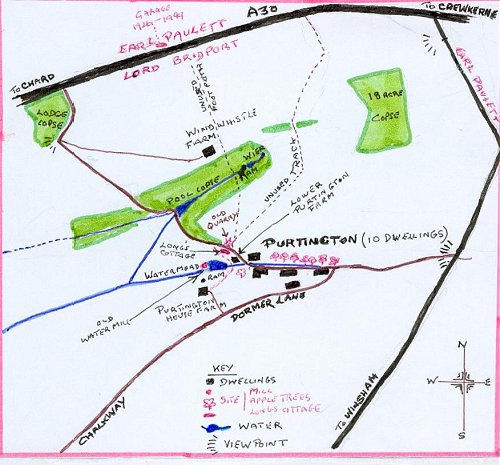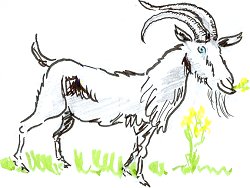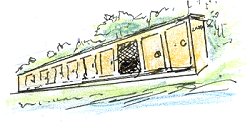|
Part 1 by Paul Smith Written in 2002
At the end of the Ice Age - some 10,000 years ago -
after the icy waters had swept, in a westerly direction off the
Windwhistle Ridge, several little combes were left in the landscape.
From the top gate on the Winsham road - just off the A30 - the first
combe looks down over Windwhistle Farm and over Cricket St Thomas woods
to the sea at Seaton gap, some twelve miles distant . The next combe -
half a mile further along the road - is the lane down a steep hill which
disappears into the eastern end of Purtington hamlet. I seldom go
through there now; for modem society - the motor car and the fanning -
have destroyed much of the beauty and all the magic that I once knew and
loved. I spent all my early years - between the Wars - as a farm lad in
this green, lush and magical setting. Where each human personality could
develop in isolation uncluttered by modem media and fashion. 
On the old maps the area north and east of the A30 and Winsham roads are
shown as the lands of Earl Paulett . To the south and west (Winsharn
parish) is shown as the lands of Lord Bridport. When I first came to
Newhouse Farm (now Windwhistle Farm) in 1921 the new winding lane had
been constructed a mile further west along the A30 to enter Purtington
from the west.
Lord Bridport had sold all his Cricket estate to Mr Fry and in 1919 a
Mrs Hall had bought the main Cricket St Thomas estate. The five outlying
farms and the hamlet of Purtington were offered for sale to private
farmers. Mr Tom Corr, a great Irish character, bought two farms and
Purtington hamlet, and farmed some 500 acres. As a Roman Catholic he let
many of the houses to fellow Catholics and at one time there were 19
Catholics in Purtington. My father bought Newhouse Farm in 1921. During
Lord Bridportís reign estate workers, including a cobbler (a Mr
Hoskins), filled the houses and all hedges were laid, ditches were dug
and copses, spinneys, coverts and fences were properly maintained mainly
in the interests of shooting and hunting. Ponds and watercourses were
carefully maintained and unpolluted. Brightly coloured apple orchards,
mostly for cider, lined the approach to Purtington and opposite the
houses. Roses often lined the doors under the bright yellow of the
thatched roofs. The old building-stone quarry, with vertical walls, lay
conveniently opposite the first dwelling - Long' s Cottage. Barn
owls could usually be seen from here just before dusk. One tree in the
orchard here grew very large, and very juicy, Morgan Sweet apples - a
magnet for small boys.
Toward the centre was Lower Purtington Farm - a very mixed holding with
a few cows, some fattening cattle, sheep, pigs, mixed poultry - a little
of everything. Hay was the main winter feed. Despite the fact that, like
so many village farms, the fields and buildings occupied both sides of
the road residents accepted the minor disturbances as part of life. The
whole of Purtington was overlooked - from further up the hill - by
Purtington House and farm, with a large walnut tree in front of the
buildings. My isolated home was approached along the old track and
footpaths across the combe and stream to the far side of Pool copse.
(See map).
The stream that started beside the houses ran alongside the farm yard
under the track to Purtington House and to a large pond that powered the
saw mill, with its overshot water wheel, as it continued on down through
Watermead (now an SSSI) to Cricket St Thomas and the Axe River. There
was a large concrete basin in the stream beyond the mill that was used
as a sheep dip.
What you may see now (2002) is but a shadow of the Purtington of old.
The basic underlying structure is still there - the pond, the stream,
the winding lane, a few cottages and the isolation. Two ugly brick
cottages now face the old three-story farm house with its minstrel's
gallery and 'cellar', with outside steps up to the third story now
decaying under a coat of ivy. The old quarry has served as a silage pit,
Long's Cottage has gone and there is not an apple tree in sight. The old
Water Mill is but a shell and the Mill Pond has silted up. Most of the
little farm hedges have gone to make way for the use of the forage
harvester and the hundred cow dairy herd. There is a now a central red
telephone box, a range of modem farm buildings, the old central barn has
gone but the 'barn' (the Chapel) on the top (Dormer) lane has become a
house. Several of the houses have been modernised.
I lived at Newhouse Farm (now Windwhistle Farm) all my childhood and
working life. So to finish this exhibit I now recall some of the little
happenings which make Purtington such a happy memory.
The
Sheep Dip
In the 1920's the
 sheep
were penned at the side of the dip. The shepherd would pick up a
sheep by the wool on its back and deftly swinging it through the air
he would propel it into the dip. A young worker was given the chance
to try his hand. To my childish delight he picked the sheep up and
with a wild swinging motion propelled himself into the dip to the
obvious surprise of the sheep still standing on the edge. He was
duly fished out with the sheep already in the dip. sheep
were penned at the side of the dip. The shepherd would pick up a
sheep by the wool on its back and deftly swinging it through the air
he would propel it into the dip. A young worker was given the chance
to try his hand. To my childish delight he picked the sheep up and
with a wild swinging motion propelled himself into the dip to the
obvious surprise of the sheep still standing on the edge. He was
duly fished out with the sheep already in the dip. |
 |
The Goat
In the early 1920's the aged farmer
Snell used to fetch the cows for evening from a distant field
walking very slowing behind the herd followed very closely by a
large billy goat. When my mother asked him "why do you have a goat?
he replied that the goat prevented the cows 'slipping' their calves.
It was many years before I fathomed that goats eat the poisonous
plants, including ragwort, that would grow in the fields. I recall
that when mother also asked him if he had a watch he replied that he
never had one as it would not make him walk any quicker. |
The Plough
At the start of the war Mr Tom Corr objected
when a 'War Ag' tractor and driver turned up on a Sunday to plough his
field. While Mr Corr quoted the bible about keeping the Sabbath holy,
the driver later told me that he quoted the old proverb. 'The Better the
Day the Better the Deed!' The ploughing went ahead.
The
Gudgeon Pin
One of the greatest characters that ever
thrived in Purtington was the late farmer Teddy Forward. With his
'ten gallon' hat and substantial figure Teddy was as 'strong as an
ox' and as colourful as a bright autumn sunset. He reckoned he
made the strongest cider in all Somerset. Teddy was also a man of
his word and a lover of surplus sales. He delighted in promising to
help a neighbour. One day he promised to get me a cheap gudgeon pin
for my tractor. Only a few days after he had handed it to me did I
discover a fresh old tractor in his junkyard under a hedge - with
the gudgeon pin missing! |
 |
|
The Henhouse
I had heard that Teddy had promised to
get a neighbour a special size henhouse. Shortly afterwards parked
on the verge just down from Long's Cottage was a wooden ten seater
ex-government cubicle toilet, in practically mint condition. With,
of course, one door missing! - and a grateful neighbour. |
Cider with Dicker
In one of the great autumn gales of the early 1960s the great ash tree
that looked over my farmyard came crashing down. Teddy promised to cut
it up to clear the exit the following morning. Teddy turned up on time
in his Landrover, a firkin of cider and his friend Dicker with a chain
saw .
It was a very hot day and after some effort the chain saw started and
Dicker cut two large sections, which Teddy duly rolled to the side.
They celebrated each cut with a sip of cider. The late Dicker was a very
large red-faced younger man and at this stage his nose started bleeding
profusely. They decided to continue working but the blood was falling on
to the saw chain, which propelled it over both men, the tree and indeed
anything within ten yards.I decided to keep out of the way but on my
return, when I heard the saw stop some half an hour later, the entire
scene was vivid red. The exhausted Dicker was lying on his back on the
ground with arms outstretched and Teddy was pouring the last drops of
cider into his mouth directly from the stone firkin. It was just
mid-day. Teddy was, indeed, a man of his word .
It was a very hot day and after some effort the chain saw started and
Dicker cut two large sections, which Teddy duly rolled to the side.
They celebrated each cut with a sip of cider. The late Dicker was a very
large red-faced younger man and at this stage his nose started bleeding
profusely. They decided to continue working but the blood was falling on
to the saw chain, which propelled it over both men, the tree and indeed
anything within ten yards.I decided to keep out of the way but on my
return, when I heard the saw stop some half an hour later, the entire
scene was vivid red. The exhausted Dicker was lying on his back on the
ground with arms outstretched and Teddy was pouring the last drops of
cider into his mouth directly from the stone firkin. It was just
mid-day. Teddy was, indeed, a man of his word
.
|

 sheep
were penned at the side of the dip. The shepherd would pick up a
sheep by the wool on its back and deftly swinging it through the air
he would propel it into the dip. A young worker was given the chance
to try his hand. To my childish delight he picked the sheep up and
with a wild swinging motion propelled himself into the dip to the
obvious surprise of the sheep still standing on the edge. He was
duly fished out with the sheep already in the dip.
sheep
were penned at the side of the dip. The shepherd would pick up a
sheep by the wool on its back and deftly swinging it through the air
he would propel it into the dip. A young worker was given the chance
to try his hand. To my childish delight he picked the sheep up and
with a wild swinging motion propelled himself into the dip to the
obvious surprise of the sheep still standing on the edge. He was
duly fished out with the sheep already in the dip.

 .
It was a very hot day and after some effort the chain saw started and
Dicker cut two large sections, which Teddy duly rolled to the side.
They celebrated each cut with a sip of cider. The late Dicker was a very
large red-faced younger man and at this stage his nose started bleeding
profusely. They decided to continue working but the blood was falling on
to the saw chain, which propelled it over both men, the tree and indeed
anything within ten yards.I decided to keep out of the way but on my
return, when I heard the saw stop some half an hour later, the entire
scene was vivid red. The exhausted Dicker was lying on his back on the
ground with arms outstretched and Teddy was pouring the last drops of
cider into his mouth directly from the stone firkin. It was just
mid-day. Teddy was, indeed, a man of his word
.
It was a very hot day and after some effort the chain saw started and
Dicker cut two large sections, which Teddy duly rolled to the side.
They celebrated each cut with a sip of cider. The late Dicker was a very
large red-faced younger man and at this stage his nose started bleeding
profusely. They decided to continue working but the blood was falling on
to the saw chain, which propelled it over both men, the tree and indeed
anything within ten yards.I decided to keep out of the way but on my
return, when I heard the saw stop some half an hour later, the entire
scene was vivid red. The exhausted Dicker was lying on his back on the
ground with arms outstretched and Teddy was pouring the last drops of
cider into his mouth directly from the stone firkin. It was just
mid-day. Teddy was, indeed, a man of his word